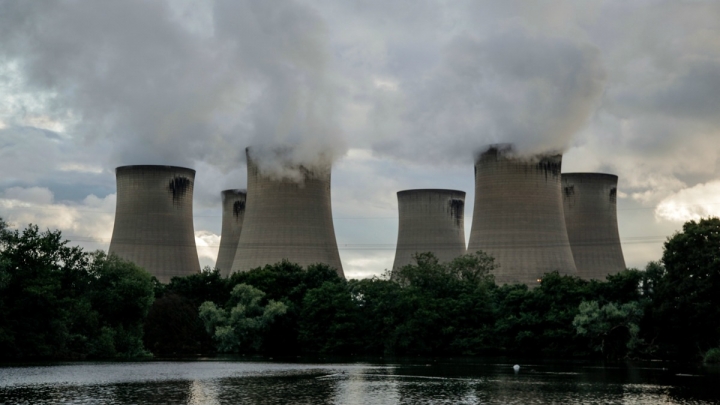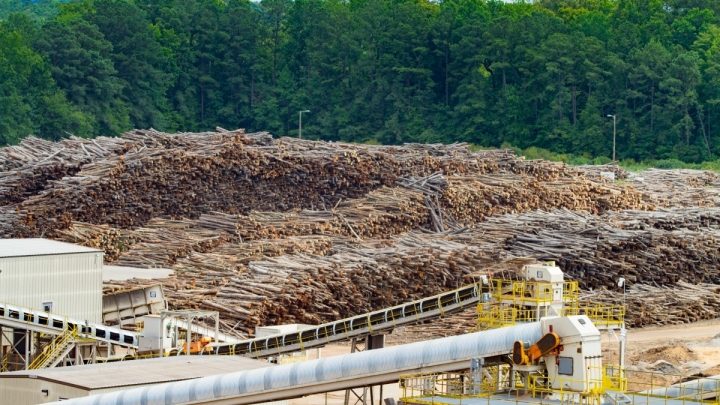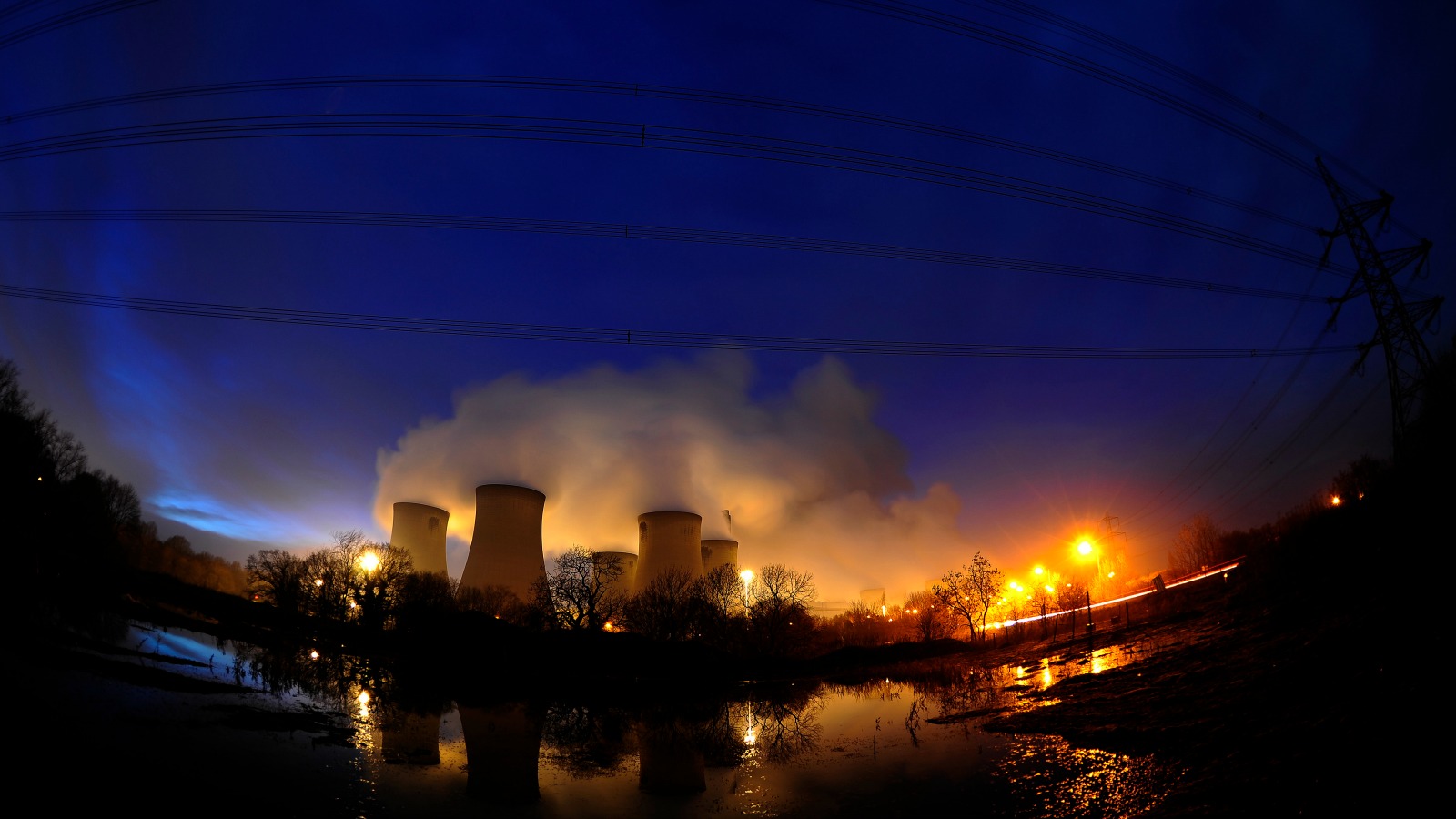As American foresters ramp up logging to meet the growing demand for wood pellets by power plants on the other side of the Atlantic Ocean, a new European wood energy proposal would allow the power plants to continue claiming their operations are green for at least 13 more years, despite releasing more heat-trapping pollution than coal.
Most of the wood fueling converted coal plants in England, Denmark, and other European countries is coming from North American forests. Each month, about 1 million tons of tree trunks and branches from southern U.S. pine plantations and natural forests is being turned into pellets and shipped to European power plants, mostly to Drax power station in the U.K.
The growing transatlantic trade is being financed with billions of dollars in European climate subsidies because of a regulatory loophole that allows wood energy to count as if it’s as clean as solar or wind energy, when in reality it’s often worse for the climate than burning coal. Only the pollution released when wood pellets are produced and transported is counted on climate ledgers. Actual pollution from the smokestack — by far the greatest source of carbon pollution from wood energy — is overlooked.

Rajan Zaveri/Climate Central
This flaw of treating bioenergy as “carbon neutral” is enmeshed in climate policies and models worldwide. Its impacts have become apparent in recent years as European power plants were encouraged to switch from coal to wood, and as the U.S. increased the amount of biofuel that must be blended into gasoline. Both policies are touted as green but are harming the climate and environment.
A proposal to extend the carbon neutral loophole for at least 10 more years was included in draft clean energy rules for 2021 to 2030, recently unveiled by the European Commission. The rules provide a regulatory path forward for ensuring the European Union meets its 2030 pledge under the Paris climate agreement. If they become law following votes in European Parliament, as currently drafted, that path forward would be paved with deceitful accounting practices.
The proposed rules were released just a few months after the commission released a 361-page warning about the risks to the climate and American wildlife from the growing use of wood in the continent’s power plants.
“They’re acknowledging that there’s an issue there, but they’re not taking immediate action,” said David Carr, an attorney with the Southern Environmental Law Center, which is one of the environmental groups in Europe and the U.S. uniting in a campaign to oppose most wood energy. They have been pushing for new rules that could halt the use of subsidized wood for electricity in Europe after 2020. “It’s a big disappointment.”
A Climate Central analysis last year found that switching from coal to wood increased carbon dioxide emissions at Drax power station in rural England by 15 to 20 percent for each megawatt produced.
Yet Drax doesn’t have to count those emissions as climate pollution, nor does it have to pay the carbon fees owed when fossil fuels are burned. Cutting down trees to produce so-called biomass energy also reduces a forest’s ability to absorb carbon dioxide. Producing and shipping the pellets worsens climate impacts — and those are the only climate impacts from wood energy for which Drax is held accountable by European authorities.
On Dec. 19, the European Commission announced it had completed an investigation into the wood market and environmental impacts from the U.K.’s financial support for Drax, concluding the wood energy subsidies comply with European Union rules.
European demand for American wood pellets has skyrocketed from zero in less than a decade, prompting nearly 40 mills to be built or planned throughout the South, according to analysis by Carr’s group. The mills are often opposed by neighbors and environmental groups worried about pollution, deforestation, and heavy 24-hour truck traffic.
Public subsidies on both sides of the ocean enrich the industry. European countries subsidize the pellet purchases by energy companies while county and southern state governments in America subsidize pellet producers with tax breaks and free land.

Southern Environmental Law Center
The European Commission’s proposal wouldn’t close the wood energy loophole, as many had hoped, but it does include some measures that aim to reduce its impacts, including rules designed to protect natural forests and wetlands. Most of the measures were dismissed by environmental groups as inadequate. Those groups tepidly welcomed one proposed rule, however, which would impose efficiency restrictions on new wood-burning power plants.
The legislation was welcomed by members of the burgeoning wood energy sector, which could quickly collapse if European subsidies are yanked. “We look forward to continuing our work” with European officials “to ensure these proposals are practical yet sufficiently robust,” the U.S. Industrial Pellet Association said in a statement.
If the rules are adopted as currently drafted, the association’s members expect to continue selling wood pellets to heavily subsidized power plants at least until 2030, helping European countries comply with European Union climate rules despite increasing the amount of warming caused by the power plants. (Rules covering the period after 2030 will be considered in future years.)
The E.U. aims to reduce climate emissions to 20 percent below 1990 levels by 2020. With global warming nearing 2 degrees F since the early 1800s, fueling heat waves, floods, and coral die-offs, the E.U. pledged under last year’s U.N. Paris climate agreement to reduce emissions another 20 percent by 2030.
With wood heating widespread through Europe and electricity from wood becoming commonplace, wood energy accounts for nearly half of Europe’s renewable energy production. If the accounting sleight of hand was abolished, it could reveal that the E.U. is falling short of climate targets. It would also demand more ambitious and costly efforts to meet future ones.
In August, the European Commission appeared to be leaning toward trying to close the loophole, with the release of a report detailing the heavy risks that wood energy posed to American forests and the climate. At the time, pellet producers characterized potential reforms outlined in the report as “overzealous” and “a classic example of a solution in search of a problem.” When the commission came out with its new proposed energy rules, reforms described in the report were largely absent.
The European Commission declined interview requests for this story, but in emails, a spokesperson said its biomass energy proposal “mirrors international rules” and that it was crafted to avoid “double counting.” Such double counting would occur if one country reported carbon pollution from deforestation when pellets were produced, reducing forest carbon, and then another country reported the pollution when the wood was burned for electricity and sent into the atmosphere.
Such an approach could theoretically ensure that climate impacts of wood energy are accounted for somewhere and paid for by somebody through a carbon pricing program. But that would require an extraordinary overhaul of global climate policy.
In reality, the approach disguises the climate impacts of wood power by spreading responsibility for pollution away from individual power plants, where pollution is heavily regulated and taxed under Europe’s carbon trading program, to foreign nations’ forestry sectors. There, the pollution can be easily overlooked and it is not taxed. The result is climate subsidies for power plants that can perversely accelerate climate change.

Ted Blanco/Climate Central
“Relegating the emissions to another sector does avoid double counting, but it also means that other sectors might not pick it up,” said Oregon State University professor Mark Harmon, a member of a panel that provides scientific advice to the EPA about measuring pollution from bioenergy. “It basically provides a whitewash.”
Some scientists are supportive of such an approach — but only theoretically.
“This can all work as long as there is comprehensive accounting,” said John Reilly, a director of the Joint Program on the Science and Policy of Global Change at MIT who serves on the EPA panel with Harmon.
For the approach to work, pollution pricing and other climate programs as stringent as European rules affecting energy would need need to be in place protecting all of the forests that supply the continent’s wood pellets. Those forests lock carbon on land, keeping it out of the atmosphere.
“Given the loose enforcement and targets for greenhouse gas reductions in many parts of the world,” Reilly warned that “incentives to avoid deforestation” could remain insufficient. “In general, I think moving in this direction is a good thing — if incentives for saving carbon on land are in place.”
Some European Commission scientists were hoping that the proposal would include robust rules for reporting wood energy’s climate impacts. But such reforms lack political backing. That’s partly because of the overwhelming potential consequences of reform, and partly because few policymakers grasp the science of wood energy.
Misinformation about the climate impacts of wood energy is rife, with industry groups touting non-scientific assumptions to make false claims about greenhouse gas savings. American forestry companies operate a blog that attacks the credibility of scientists, journalists, and activists who point to wood energy’s risks and harms.
Industry groups claim burning wood is better for the climate than burning fossil fuels because trees grow back. Yet both practices shift carbon from near the Earth’s surface into the atmosphere, where it traps heat, while doing little to directly promote forest growth.
Compounding the confusion, news reports frequently cite on-paper climate gains from wood energy instead of real-world increases in greenhouse gases flowing through smokestacks after coal power plants have been converted.
While the impacts of wood pellet burning are being experienced globally as greenhouse gas emissions rise, the impacts of wood pellet production are being felt locally in parts of the U.S., Canada, and some European countries, where most pellets are being produced.
Wetland forests have been cut down to help meet growing demand for pellets. Pellet mills operate around the clock, powered by burning bark, which causes air pollution. Wood dust from pellet mills settles on neighboring properties. Trucks powered by polluting diesel deliver trees and wood chips to the mills and pick up pellets, jamming roads.
Even before the European Commission proposed locking the wood energy accounting flaw in place throughout the 2020s, Enviva Biomass, America’s leading producer of wood pellets for European power plants, had been gambling that it would do so, announcing heady plans for expansion.
Enviva has developed a cookie-cutter approach to building its mills, improving efficiency and reducing costs. A close relationship with Drax has provided long-term contracts that help it obtain financing. The company owns or operates mills and ports in Virginia, North Carolina, Florida, Mississippi, and Alabama, with plans to expand to South Carolina and Georgia announced or under consideration.
The company recently built a new mill in North Carolina after Sampson County agreed to provide a $2 million package of nearly 200 acres of land near freeways plus development assistance. The county also promised tax breaks, which are contingent upon the company employing a minimum number of workers.
Enviva declined to comment for this story but John Swope, the county’s economic development director, said the incentives were offered to entice the company to build its mill within county limits instead of in nearby Wayne or Duplin counties. “When you get a project like Enviva Biomass’, they were looking to have something within this region,” he said. “It is a competitive process.”
Enviva’s Sampson County mill has the capacity to chew through more than a million tons of wood every year. Located 70 miles from a port from which pellets are now being shipped to Europe, its wood comes from trees growing in the North American Coastal Plain. Stretching south to Florida and then west along the Gulf Coast to Texas, most of the natural habitat in the heavily forested, globally recognized wildlife hotspot has been destroyed.
The pellet mills are big buyers of native hardwood trees, which they target to reduce competition with existing industries that rely on plantation pines. That angers environmental groups that have spent decades fighting to protect natural Southern forests.
“It’s additional pressure on the forest,” said Adam Macon, a campaigner with Asheville, North Carolina-based Dogwood Alliance, a nonprofit that coordinates protests against wood pellet producers. “It’s additional logging of the forest. It’s an additional demand.”

John Upton/Climate Central
Dogwood and other groups say they will oppose the new European Commission proposal.
“It’s important to acknowledge that this is a draft policy,” Macon said. “The fight now goes to the Parliament.”
While the impacts of the industry on forests throughout the South have not been well studied, research published in the journal GCB Bioenergy this fall by government and academic researchers warned of wildlife impacts throughout North Carolina.
Researchers used models to project impacts on habitats used by different birds and amphibians using various scenarios of wood pellet and biofuel production, comparing those with a future in which no bioenergy was produced. All led to habitat changes. “There are winners and losers under any scenario,” said Nathan Tarr, a North Carolina State University ecologist on the research team.
To North Carolinians who treasure hardwood forests that are recovering amid logging and land clearing, pine planting and urbanization, new Enviva mills in Sampson County and 100 miles west in Richmond County are seen as posing major risks.
Sometimes the native hardwood forests are left to slowly regrow after they’re cut down. Sometimes the land is poisoned with herbicide and planted over with monoculture plantations of faster-growing pines.
If European lawmakers agree to preserve the carbon accounting flaw through 2030, nations will have an incentive to continue wood burning instead of relying on clean energy sources like solar and wind energy. To meet the demand, proposed new mills would almost certainly continue to be built through the South.
“When they get done cutting down the forests and planting trees, where’s going to be the oaks, the maples, the sweet gums, the hickory?” said Jean Thornton, who has lived for more than 60 years next to the site where Enviva built its Sampson County mill. “They take a long time to grow back.”



